![]()
|
|
Bhava Leela
(the Play of Divine Trance)
How it Started
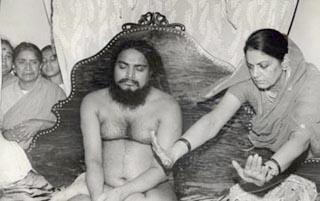
Above: Mataji, Srimati Kailas Kumari Devi, in bhava samadhi, giving protection to Shivabalayogi on August 6, 1968, the night before he began one year of tapas at the Bannergatta Road ashram.
Below: Shivabalayogi’s mother, Parvatamma, in bhava samadhi during bhajans at the Bannerghatta Road ashram, Bangalore.
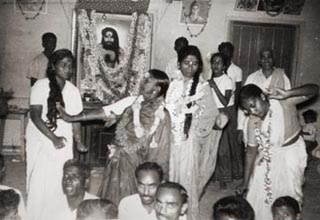
Bhava Leela
(the Play of Divine Trance)
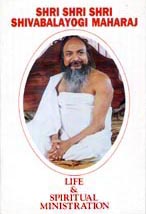 The main text on this webpage is the "Bhava Leela" chapter from the book,
The main text on this webpage is the "Bhava Leela" chapter from the book,
Shri Shri Shri Shivabalayogi Maharaj, Life & Spiritual Ministration,
the biography of Shivabalayogi first published in 1981,
by Gen. Hanut Singh.
Read the complete book, 1989 edition,
online HERE.
bhava — literally existence, it also refers to modes of existence, moods, or attitudes, and therefore states of trance.
bhava samadhi — divine trance; any of different ecstatic states induced through the presence of divine souls, particularly during bhajans (spiritual song).
ishtadeva — the way or form in which a person imagines or prefers to worship God; e.g., Jesus, Allah, Buddha, Shiva or the Great Spirit.
kirtan, bhajans — spiritual song
Read what Shivabalayogi had to say about Bhava Samadhi.
One day, shortly after he had completed twelve years of tapas, Sri Swamiji was giving public darshan when a small group of people came to the ashram and began questioning Sri Swamiji on various spiritual matters. One of the topics discussed was the question of free will. Some from among those participating in the discussion maintained that each one of us was free to act as he willed. Having listened to their talk for some time, Sri Swamiji interjected at this stage, “Let alone being free to act according to our individual will and desire, even this body that we regard as our own is not ours.”
He then looked at a particular individual in the group, who had been taking a leading part in the discussion, and asked him pointedly, “Well! Is this body yours?”
Somewhat bewildered, the man replied, “Why, yes of course. If my body is not mine, then whom else does it belong to?”
Sri Swamiji smiled and said, “If that be the case then let me see you control it and move it as you like.”
With these words Sri Swamiji, through his spiritual power, induced the state of bhava in all those sitting directly in front of him. Under the influence of this bhava, they soon forgot themselves; they started swaying to the music of the bhajans and without any previous resolve or will on their part, their hands automatically started to adopt various mudras (poses of the hand). Sri Swamiji told them to control themselves and remain still, but in spite of themselves they could not and they continued to act as though they were being controlled by some mysterious power from within. After this had gone on for some time, vibhuti [sacred ash, blessed by Shivabalayogi] was applied to their foreheads, between the eyebrows, and they immediately regained their normal state of consciousness.
By this means Sri Swamiji dramatically demonstrated to all those present that men were mere playthings in the hands of the Divine and, therefore, foregoing ego, we should surrender ourselves to the Divine Will in everything we do.
This was the beginning of Sri Swamiji’s unique method of bringing people round to the spiritual path by inducing bhava in them. Today, this is no longer regarded as a strange phenomenon. In fact, it is one of the common features of congregational bhajans conducted by devotees of Sri Swamiji.
Bhava and Bhava Samadhi:
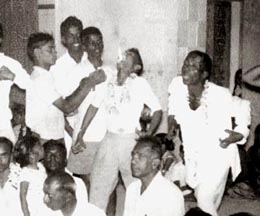 The term bhava implies a mood or an attitude of
mind. When used in the context of spiritual practices, it connotes spiritual
moods or attitudes, as explained below:
The term bhava implies a mood or an attitude of
mind. When used in the context of spiritual practices, it connotes spiritual
moods or attitudes, as explained below:
In one sense, the term bhava is used to denote the devotional altitude that a devotee adopts towards his ishtadeva (chosen ideal of the Supreme Godhead). These devotional attitudes have been categorized into five different types:
-
sant bhava or the saintly attitude of devotion such as adopted by the rishis of yore;
-
dasya bhava or the attitude of a servant towards his master as exemplified by Sri Hanuman;
-
sakhya bhava or the attitude of a friend as exemplified by Arjuna and Udhava towards Sri Krishna;
-
vatsalya bhava or the attitude of a mother towards her child as exemplified by Kaushalya towards Sri Rama and by Yashoda towards Sri Krishna; and finally,
-
madhur bhava or the attitude of a woman in love as exemplified by Radha and Meera towards Sri Krishna.
In another sense, the term bhava is also used to denote the spiritual mood characteristic of ones ishtadeva, e.g., Ram bhava or Shiva bhava or Gauri bhava and so on.
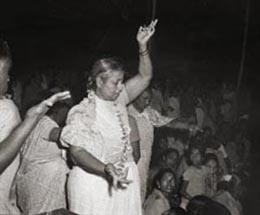 Finally, bhava denotes the mood of
ecstasy and self surrender which is induced by the maturing of devotion
to ones ishtadeva.
Finally, bhava denotes the mood of
ecstasy and self surrender which is induced by the maturing of devotion
to ones ishtadeva.
The depth of the bhava experience varies with different individuals and depends on the spiritual maturity of their minds. Very broadly speaking, the bhava experience could be categorized into three stages as follows:
-
In the first stage the devotee experiences peace and spiritual exaltation. It is a very desirable experience which he wants to repeat again and again, which in turn motivates him to further effort on the spiritual path. As he progresses, he may also start experiencing ananda (bliss) in varying degrees.
-
With further deepening of the bhava, the devotee experiences the second stage during which he sees visions of his ishtadeva and other devis [gods], devatas [divine beings] and saints. These visions and spiritual experiences purify the devotees mind and prepare him for the third and final stage.
-
Finally, in the third stage, when the bhava has fully ripened, the devotee experiences bhava samadhi.
As the state of bhava develops, a devotee gradually gets rid of the dross in his mind and with that he acquires spiritually desirable qualities such as faith, renunciation and strength of character. His whole personality undergoes a transformation and, in many cases, even bodily changes take place. However, it needs to be pointed out here that outward manifestations are no indicator of a devotees inner development. The less mature devotees are usually unable to absorb spiritual experiences and in their case it is often seen that even a minor or passing spiritual experience creates a mental and physical upheaval. As opposed to this, spiritually mature devotees may have profound spiritual experiences, but they will not exhibit any outward signs which may be indicative of the depth of their experiences.
Bhava: a Historical Perspective
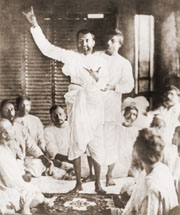 Left: Ramakrishna Paramahansa (1836–1886), mystic and yogi from Bengal,
in bhava samadhi.
Left: Ramakrishna Paramahansa (1836–1886), mystic and yogi from Bengal,
in bhava samadhi.
Below: Chaitanya Mahaprabhu (1486–1534) and followers singing bhajans and in bhava. Chaitanya, a social reformer in eastern India, is revered by followers as an incarnation of Lord Krishna. Chaitanya promoted the path of devotion (bhakti), particularly towards the Divine lovers, Radha and Krishna.
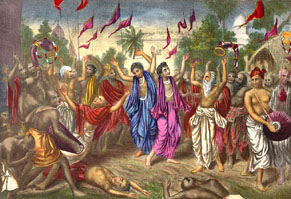
Ecstatic states of spiritual trance (bhava samadhi) are part of all spiritual traditions, including those within Christianity (baptism of the Holy Spirit), Islam (Sufi dervishes), Tibetan Buddhism, and shamanism. They are expressions of Divine love.
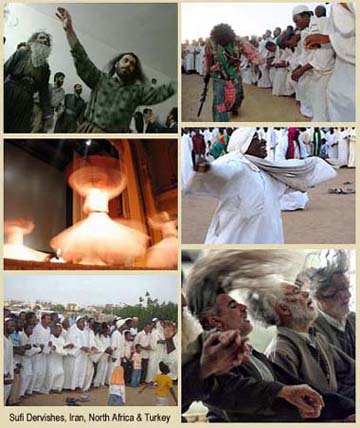
There is nothing new or unique about bhava and bhava samadhi. They are as old as spiritual practice itself. The characteristics of bhava and bhava samadhi have been visibly manifest in almost all followers of the bhakti marga (the path of devotion). These characteristics are also manifest in followers of other spiritual paths, but to a some what lesser extent.
Those who are familiar with religious literature will have read accounts of the manifestations of bhava in the kirtan parties led by Sri Chaitanya and his chief disciple Nityananda. In more recent times, Sri Ramakrishna was a living embodiment of bhava and all that it implies; his biographers have recorded that in accordance with the directions of the Divine Mother, he lived in bhavamukha [appearance of trance] all his life, and this notwithstanding the fact that he had attained to the ultimate non-dual state through nirvikalpa samadhi [samadhi where consciousness is completely dissolved in God].
Uniqueness of Sri Swamiji’s Bhava Leela
Seeing that bhava has been a common feature of spiritual practice through the ages, what then is the uniqueness of Sri Swamiji’s bhava leela? Simply stated, it is in the widespread and unstinted manner in which Sri Swamiji employs bhava to bring people to the spiritual path. No doubt we read about Sri Chaitanya and Sri Ramakrishna inducing bhava in others, often on a large scale, but this was usually restricted to their chosen disciples and followers. In the case of Sri Swamiji, bhava spreads like an all engulfing wave whenever bhajans are conducted by his devotees, and almost all those present are affected by it to a greater or lesser extent. Thus is observed the extraordinary sight of men and women of all ages, and particularly children, lost to the outer world in ecstasy, dancing to the beat of the devotional music, and exhibiting in themselves the characteristics of the Puranic gods and goddesses, and of the ancient saints and rishis.
Another unique feature is that Sri Swamiji’s physical presence is not at all necessary for the manifestation of this bhava. He will usually be sitting in the darshan hall, or even in his own room, whilst bhajans may be going on in a separate room or in the courtyard of the ashram, and yet the manifestation of bhava will go on just as if he was present. In fact Sri Swamiji may be miles away, at a different place, and yet by his grace devotees will experience bhava whenever and wherever they may chose to conduct kirtan, after invoking his blessings.
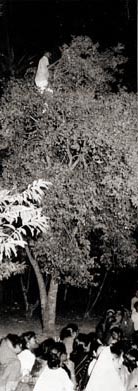 Some interesting and often incredible features of
the bhava induced by Sri Swamiji are that a throng of people will dance and move
about entranced for hours on end, without any signs of fatigue, and without so
much as running into each other or tripping or disturbing any of the other
devotees. Those devotees who get Hanuman bhava, or some other simian
bhava, can
be observed climbing up slender trees, dancing atop fragile branches, dangling
from them in simian fashion and finally jumping down without so much as a
scratch. Once the bhajans are over, those who were in deep bhava are brought
back to normal consciousness by applying consecrated vibhuti [ash
blessed by Shivabalayogi] on the point
between their eyebrows.
Some interesting and often incredible features of
the bhava induced by Sri Swamiji are that a throng of people will dance and move
about entranced for hours on end, without any signs of fatigue, and without so
much as running into each other or tripping or disturbing any of the other
devotees. Those devotees who get Hanuman bhava, or some other simian
bhava, can
be observed climbing up slender trees, dancing atop fragile branches, dangling
from them in simian fashion and finally jumping down without so much as a
scratch. Once the bhajans are over, those who were in deep bhava are brought
back to normal consciousness by applying consecrated vibhuti [ash
blessed by Shivabalayogi] on the point
between their eyebrows.
Benefits of Bhava
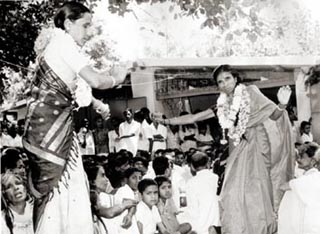 Those who are blessed by Sri Swamiji with bhava,
derive a number of invaluable benefits; these are as follows:
Those who are blessed by Sri Swamiji with bhava,
derive a number of invaluable benefits; these are as follows:
-
Diseases, including chronic diseases, are cured.
-
God-consciousness is instilled.
-
The ego sense is subdued and is replaced by a spirit of self surrender to the will of God.
-
An absolute and implicit faith in God is instilled.
-
Pain and misery, due to mental or physical causes, are removed.
Bhava: a Personal Experience
In order to explain better what bhava is and to illustrate how it works, one of the devotees has written a vivid account of his personal experience of bhava, which was given to him through the grace of Sri Swamiji, and of the beneficial effects of this bhava on his life and on his subsequent spiritual development. This account is given below for the benefit of those readers who would like to have a clearer understanding of this phenomenon.
“I arrived one evening at our summer house at Dehradun, literally dragged by my parents, to meet a sage who was staying there as their guest. Reluctant as I was, I had resolved to come only for a day, more as a courtesy to my parents rather than from any personal desire to meet this saint, and had planned to be off the same evening, back to Lucknow.”
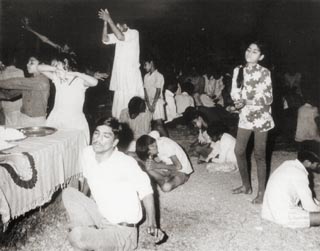 “On entering the house I witnessed some strange
scenes. I saw some of my relatives, as also some outsiders, standing around in
fancy dance poses, or just walking around and smiling. It was strangely
reminiscent of the Ranchi Mental Institute which I had once visited. Though
basically religious, I was somewhat skeptical of the many sadhus of our
times and so, keeping my opinions to myself, I walked into the house with
strange misgivings. Little did I know then that as I went into the house, I was
moving steadily and surely towards one of the most moving and profound
experiences of my life.”
“On entering the house I witnessed some strange
scenes. I saw some of my relatives, as also some outsiders, standing around in
fancy dance poses, or just walking around and smiling. It was strangely
reminiscent of the Ranchi Mental Institute which I had once visited. Though
basically religious, I was somewhat skeptical of the many sadhus of our
times and so, keeping my opinions to myself, I walked into the house with
strange misgivings. Little did I know then that as I went into the house, I was
moving steadily and surely towards one of the most moving and profound
experiences of my life.”
“I wanted to have a bath, but I was told that mental cleanliness takes precedence over bodily cleanliness, and was led straight into the last bedroom which had been temporarily convened into a darshan room. I walked towards the room with a mental picture of a fat old sadhu [holy man], preaching a sermon on some hackneyed religious subject, with the audience, though half asleep, showing forced reverence. I entered and was amazed to see a youthful figure, silting on a tiger skin, gaily laughing and joking with a lady in white who was vigorously pleading with the yogi on some matter. Others were seated around the yogi in a large semi-circle and were enjoying the spectacle.”
“A feeling of familiarity arose within me about this yogi, but I just could not seem to place him. Suddenly, he looked at me. His powerful eyes seemed to grip mine, and this feeling of familiarity that I had been experiencing took concrete shape in the thought, ‘I know him. I have known him always, since bygone ages.’ But this was a fleeting thought which flashed through my mind and was gone. The yogi was back to chatting with the lady in white, and I went back to my strange misgivings.”
“Evening came. During the darshan, one of the yogis devotees sang a few catchy bhajans. I saw some of my relations, and some others whom I did not know, sway with the rhythm of the music. Watching them, I felt rather dubious about the whole affair. Nevertheless, I was intrigued to see them dancing gracefully and vigorously in the confined space of the small room, without bumping into each other, or disturbing any of the others seated there. Some among them touched other devotees on the forehead and, thereby, appeared to transfer spiritual grace. The yogi sat with his eyes closed as if unaware of the strange happenings around him. As the kirtan progressed, the atmosphere in the room became heavy, as if charged by some powerful and pure radiation. I felt a compulsive urge to close my eyes; when I did so I found that all the myriad thoughts of my mind were rapidly evaporating, making the mind peaceful and quiescent. The bhajans began to sound pleasing to my ears, and an inner peace began to flow within me. I felt blissful and was beginning to enjoy this experience when, suddenly, my hands involuntarily began to rise, as if moved by some mysterious force. I opened my eyes with a shock and looked at the yogi, but I found no change in him. He continued to sit as before, with his eyes closed. Somewhat shaken by this strange experience, I dared not close my eyes again, so I sat out the rest of the evening watching what was going on around me.”
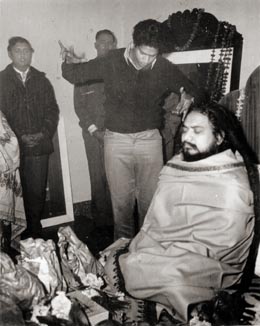 “The next day, being Sunday, some of us youngsters
had planned to go on a picnic. As a large number of people came for darshan on
Sundays, we youngsters moved into an adjoining room, from where the yogi was not
visible. We enthusiastically planned our program and discussed where we should
go to, once the bhajans were over. I felt a trace of guilt that, at such
a holy hour, we were engaged in talking about frivolous things, so I told the
group to pretend to do dhyana [meditation] for a few minutes, as otherwise my
relatives would mind it. Thereupon, we closed our eyes and began to do dhyana. After about fifteen minutes had passed, all the others opened their eyes but I
was unable to do so. I could hear the others talking. They began to jeer at me
and told me not to pretend any more. Irked by what they were saying, I tried to
open my eyes but found that they remained forcibly closed. Soon a soothing
feeling began to take hold of me and I began to reel with the music, without
even the slightest effort on my part. I heard my friends laughing, but I was
past caring.”
“The next day, being Sunday, some of us youngsters
had planned to go on a picnic. As a large number of people came for darshan on
Sundays, we youngsters moved into an adjoining room, from where the yogi was not
visible. We enthusiastically planned our program and discussed where we should
go to, once the bhajans were over. I felt a trace of guilt that, at such
a holy hour, we were engaged in talking about frivolous things, so I told the
group to pretend to do dhyana [meditation] for a few minutes, as otherwise my
relatives would mind it. Thereupon, we closed our eyes and began to do dhyana. After about fifteen minutes had passed, all the others opened their eyes but I
was unable to do so. I could hear the others talking. They began to jeer at me
and told me not to pretend any more. Irked by what they were saying, I tried to
open my eyes but found that they remained forcibly closed. Soon a soothing
feeling began to take hold of me and I began to reel with the music, without
even the slightest effort on my part. I heard my friends laughing, but I was
past caring.”
“I made a final effort to control myself and to hold myself still. Just then I got a big shock on my right toe, as if it had been inserted into an electric plug. I recoiled, but found that a steady force was climbing up both my legs. I was unable to move. My body became rigid. The force came right up into my stomach, accumulated there, and began to rise higher. I began to black out. A suffocating feeling engulfed me. A tremendous force started shaking me from within. I rose clutching my stomach. People around me were alarmed. They thought that I had got an attack of colic. My eyes were still closed but a force began to impel me forward. My limbs were no longer under my control. I believe I trampled over a few people as I moved forward under this involuntary forwarded propulsion, until soon I was brought to a standstill.”
“My eyes opened and I found myself standing near the yogi. I was shivering involuntarily. Once again his powerful eyes looked at me as if penetrating into my very being. He motioned me to sit down and gave me some consecrated vibhuti to drink, mixed in water. Immediately the force within me subsided and I began to sway with the music, enjoying the peaceful calm that once again enveloped me. In the minds eye came visions of many gods and goddesses and of many ancient sages. This was my first experience of bhava samadhi.”
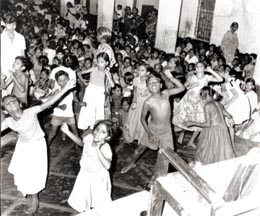 “Later I found that my personality had undergone a
complete change. Gone was my desire for worldly things. Instead, I felt a strong
urge to take up sannyas (the path of renunciation). It was as if my life
had taken a complete about turn. This intense feeling of renunciation remained
with me for over six months. During this time, I was constantly engaged in
religious pursuits and barely ever stepped out of my house. Thereafter, this
feeling gradually diminished and 1 returned to a more worldly plane, whereby I
could attend to my mundane duties. My subsequent experience has shown that this
bhava samadhi I was given has helped me greatly in the practice of dhyana. It has also come to my aid in countless ways, warning me of dangers,
mentally preparing me for catastrophes and always giving me peace, calm and
mental poise during times of distress and duress. That apart, while in bhava
samadhi, I have often been used by Sri Swamiji as a medium to heal diseases
and to transfer spiritual power to others.”
“Later I found that my personality had undergone a
complete change. Gone was my desire for worldly things. Instead, I felt a strong
urge to take up sannyas (the path of renunciation). It was as if my life
had taken a complete about turn. This intense feeling of renunciation remained
with me for over six months. During this time, I was constantly engaged in
religious pursuits and barely ever stepped out of my house. Thereafter, this
feeling gradually diminished and 1 returned to a more worldly plane, whereby I
could attend to my mundane duties. My subsequent experience has shown that this
bhava samadhi I was given has helped me greatly in the practice of dhyana. It has also come to my aid in countless ways, warning me of dangers,
mentally preparing me for catastrophes and always giving me peace, calm and
mental poise during times of distress and duress. That apart, while in bhava
samadhi, I have often been used by Sri Swamiji as a medium to heal diseases
and to transfer spiritual power to others.”
“I am ever grateful to Shri Shri Shri Shivabalayogi Maharaj for giving me this vivid experience, which has certainly proved to be a turning point in my life. The benefits of this bhava samadhi have been so many, and the experiences given to me so spiritually elevating, that these can hardly be put down in words.”
Read what Shivabalayogi had to say about Bhava Samadhi.